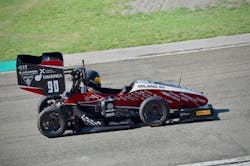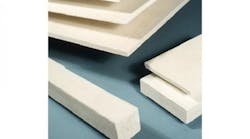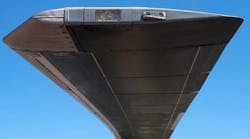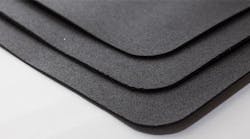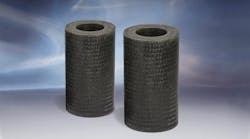Composites: The Winning Formula
Motor racing has always been at the forefront of research and development as every team looks to glean an advantage over rivals and shed away those few precious seconds per lap. To help develop automotive engineers of the future, the Formula Society of Automotive Engineers (Formula SAE) is a global student competition that pits a variety of university teams against each other to develop small, Formula-style race cars.
In 2019, the racing department at Italian university Politecnico di Milano, Dynamis PRC, was looking for a new material to improve the performance of its car’s steering column and suspensions. To accomplish this, Dynamis PRC got in touch with leading composite technology company Exel Composites to bring material innovation to high-speed engineering design.
Student projects aren’t often considered to be at the head of design sophistication. While Dynamis PRC is a student-led organization, its practices are anything but amateur. Based at one of Italy’s premier engineering universities, Dynamis focuses on designing and building formula-style vehicles to compete in the Formula SAE. While the roster may be filled with students, its hierarchy is business-like and so is its determination to learn and innovate.
After a reasonably successful year in 2018, when the team was able to secure the top ten finishes in all its competitions, Dynamis was looking for a method to push the following year’s Formula SAE car further than ever before and achieve a pole position.
Shedding Weight not Strength
“We had just come off the end of a successful year, but the team knew that our vehicle could perform better,” explains Andrea Vezzoli, technical director at Dynamis. “There were two main objectives we wanted to achieve for that year's model, named the DP11. The first was to reduce the weight of the car and the second was to improve the suspension because we felt that in the previous year, this is what had held us back.”
Singling out the steering column as the main area for weight reduction, Dynamis began searching for new materials. Making weight improvements was critical because every other team would also be finessing their cars, many of which had received support from major car manufacturers.
When researching new materials, Dynamis encountered Politecnico di Milano alumni Francesco Ierullo, who is currently Head of Sales for South and West Europe and IMEA at Exel Composites. “When they reached out, I had a flashback to my own experiences studying engineering at the Politecnico,” explained Ierullo. “I had been aware of the Formula SAE during my time studying and have been pleasantly surprised by its growth and the caliber of the design skills that many of the students in these teams possess.
“We are always looking for ways to get composites into the hands of students because they are the engineers of the future and the more experience they have with composites now, the better equipped they will be when they work in the field,” continued Ierullo. “More and more fields of industry are using composites, but direct student exposure to the material remains low. Whatever we can do to help is always crucially important to us.”
Minimizing Time and Weight
After reviewing the focus areas with the racing team, Exel Composites was able to suggest a variety of carbon fiber tubes. “During the meeting, it was great to see their passion for the project and we did our best to suggest potential methods to help with their design,” elucidates Ierullo.
“We reviewed a few different carbon fiber options before choosing the tubes we felt best suited our needs,” said Andrea Vezzoli. “Using carbon fiber was a real breakthrough for reducing the weight of the driving column. We were able to shed 15 kilograms of weight, which helped shave two seconds off our lap time.
Another bonus of carbon fiber is its strength. The car’s driving column must be able to resist three times the peak load, which for our design was 100-newton meters (Nm). Using Exel’s carbon fiber, we were able to push it to 140 Nm and the material was still functional unlike with many metals that would snap.”
“We were impressed by the performance of the material,” explained Ernesto Riccardo head of suspension and drivetrain department at Dynamis. “We built a database of materials and used an algorithm to indicate which material was best for certain components. Once we input the properties of Exel’s products into the database, the algorithm told us to use it every time without fail. It was on another level compared to everything else we had tried before.”
Exel’s tubes were also used to increase the rigidity of the vehicle’s suspension without increasing its weight. With many other materials. the forces would deform the car’s parts and reduce their effectiveness, but using carbon fiber completely avoids this issue.
Integrating Innovation
There were two main potential issues that could arise when transitioning to composites. The first issue is the difference in the methods used to cut and work the material. The risk with composites is that they become delaminated during cutting, especially while using tools such as water jets, which can cause the material to lose properties and can compromise its stability.
Another issue is that to fix the composites in place, the frame must be modified because composites cannot be welded in place. Instead, they must be glued. These modifications can alter the weight of the vehicle’s profiles, meaning that it is imperative that gluing is carried out correctly. Exel was able to prevent these problems from occurring by recommending the best options for composite material connectors, while also explaining the best way to cut each material.
“The integration process of the parts was very smooth, Exel Composites explained some necessities to us, but for the most part it was getting accustomed to gluing instead of welding,” explained Vezzoli. “The whole team was equally surprised by how easy it was to work the material; we were expecting to encounter some hiccups, but the quality of the material meant that the changeover was seamless.”
Hitting the Road Running
While Formula SAE is a racing event, there is no single race to decide a winner. Instead, each team competes in a variety of events that measure the different qualities of the cars. Stopping time, acceleration, and agility are all tested at different stages and teams are awarded points for each focus area, with the team scoring the most points winning the competition.
With the new carbon fiber pieces installed, Dynamis was able to take the car to four races. The first race took place in Holland, where the team won overall. Returning to Italy for the third race, Dynamis saw another victory.
Held in Germany, the homeland of many of the world’s largest car manufacturers, the final race was the toughest. “We were ready for challenging competition,” explains Vezzoli. “Many of the Germany teams are directly linked with their local car manufacturers, so we knew the car would have to perform well to help us hit our targets.” Even against some of the most competitive teams in the world, Dynamis was able to achieve a strong third-place position, making the season one of its most successful to date.
Forward Drive
While the 2020 season has been delayed, the Dynamis team is looking forward to its next challenge. “One of our long-term plans was to begin competing in the electric car version of Formula SAE. This was one of the reasons behind our strategic weight shedding focus for the 2019 season,” explains Vezzoli.
“Using composites has been a breakthrough for our designs,” comments Riccardi. “In fact, for the next season, we are looking to start incorporating some of Exel’s fiberglass elements in our aerodynamic wings for a new phase of lightweighting.”
Composites are becoming a mainstay in the automotive industry. Whether carmakers opt for carbon fiber of fiberglass, the potential benefits for performance, strength, and weight savings can really push what cars can do.
Exel Composites already provides composite tubes, profiles, and laminates to the automotive industry, and will continue to innovate to match the industry’s developments. Electric vehicle (EV) battery enclosures, for example, are just one instance that demonstrates how the power of a lightweight composite material holds the potential to support our increasing need for e-cars.
Racing is a constant source of innovation, not only for technology but also for the engineers that work on the cars. Material choice is at the heart of many of these innovations, with composites demonstrating numerous benefits that can make vehicles lighter, stronger, and more efficient. Making sure that the engineers of the future are exposed to composites as early as possible is key to ensuring that the next generation is ready to use the material and let it lead them to victory.
